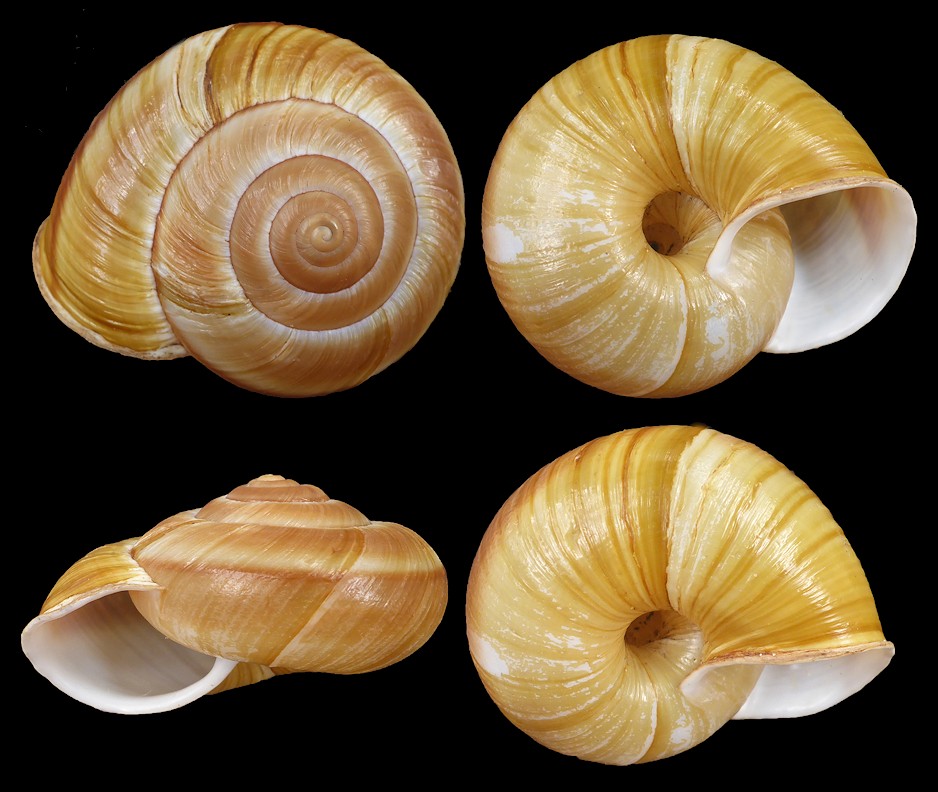|
Aegistohadra delavayana (Heude, 1885) |
|
|
|
Collected
under large stones on a high mountain, DaLi, Yunnan Peoples Republic of
China (Dmax 45 mm.) Lee Collection.
Originally placed in Nanina, this species is the monotype of
Aegistohadra Wu, 2004. Wu (Idem: 117, fig. 32 A-F) depicted
two paratypes (IZCAS-type-29021, 2 <https://www.biodiversitylibrary.org/page/28112687>)
he found in the Institute of Zoology, Chinese Academy of Sciences. They
closely resemble the iconotype (Heude, Idem: pl. 26, figs. 3 <https://www.biodiversitylibrary.org/page/34061513>).
The Holotype of this species, (and all of Heude's
taxa) probably remained in his museum in Shanghai (Fischer, 1904;
Johnson, 1973; Li-chuan, 2013), predecessor to the Shanghai Natural
History Museum. Johnson (idem) found no type material of N.
delavayana outside of China. Although a number of authentic Heude
specimens found their way to the Senkenberg Museum in Frankfurt,
Germany, no type material was included (Yen, 1939). Named for its
collector, Colonel D. Delavay. The colonel should not to be confused
with the famed French botanist Père
Jean Marie Delavay (1834-1895), who, like Père Pierre Marie Heude
(1836-1902) was a Jesuit missionary in China. Nesiohelix
meiqiui Ge and He, 2017 is a synonym fide Zhang (2019).
Fischer, P., 1904. Nécrology Le R.P. Heude. Journal de Conchyliologie 52(4): 372-375. <https://www.biodiversitylibrary.org/page/16290594> Ge, L., and J. He, 2017. Description of two terrestrial gastropod species from Yunnan Province, China. Shell Discoveries 2: 14–15. [pdf. on file] Heude, P.M. (1882-1890): Notes sur les mollusques terrestres de la vallée du Fleuve Bleu. Mémoires d'Histoire naturelle de l'Empire chinois 1(2): 2 + 1-87 <https://www.biodiversitylibrary.org/page/34061405>, pls. 12-21 <https://www.biodiversitylibrary.org/page/34061438> [1882]; 1(3): 89-132 <https://www.biodiversitylibrary.org/page/34061459>, pls. 22[23]-32 <https://www.biodiversitylibrary.org/page/34061506> [1885]; 1(4): 125-188 <https://www.biodiversitylibrary.org/page/34061527>, pls. 33-43 <https://www.biodiversitylibrary.org/page/34061594> [1890]. Johnson, R.I., 1973. Heude’s molluscan types: or, Asian land and fresh water mollusks, mostly from the People’s Republic of China, described by P. M. Heude. Special Occasional Publication 1 Museum of Comparative Zoology, Harvard University: 1-111. Before December 3 <https://www.biodiversitylibrary.org/item/25355> Li-chuan, T., 2013. English abstract; pp. 384-385 in Zikawei Museum to Heude Museum: The Natural History Research of French Jesuits in Modern China [multiple authors]. <https://tinyurl.com/27bpku9n> Wu, M., 2004. Preliminary phylogenetic study of Bradybaenidae (Gastropoda: Stylommatophora: Helicoidea). Malacologia 46: 79-125. <https://www.biodiversitylibrary.org/page/28112649> Yen, T.-C., 1939. Die chinesischen Land- und Süßwasser-Gastropoden des Natur-Museums Senckenberg. Abhandlungen der Senckenbergischen Naturforschenden Gesellschaft 444: 1-233, pl. 1-16. [pdf on file] Zhang, G., 2019. Three new synonyms among Chinese camaenid snails (Gastropoda: Eupulmonata: Camaenidae). Folia Malacologica 27(1): 75-77. <https://malacology.net/uploads/2021/03/1017308542.pdf> See also: Lee, H.G., 2022. Aenigmatic Aegistohadra Part 2 (conclusion) -or- an account of a pretty astounding clade of sinistral and enantiomorphic land snail taxa. Shell-O-Gram 63(4): 3-10. July. (Link) |
